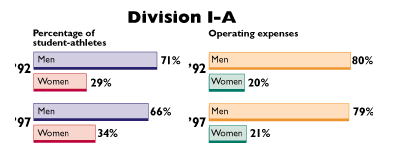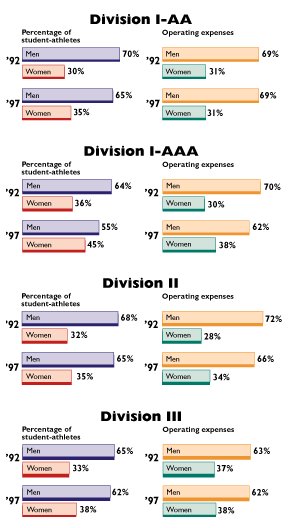The NCAA News - News and FeaturesMay 5, 1997
Dempsey: Women's gains coming too slowly
The newly released 1997 NCAA gender-equity study shows a mix of information.
 The good news is the number of women participating in intercollegiate athletics increased in every NCAA division from 1991 to 1996.
The good news is the number of women participating in intercollegiate athletics increased in every NCAA division from 1991 to 1996.
The bad news is the gains for women are offset by decreases in participation opportunities for men and escalating operating expenses for athletics.
Results of the 1997 study, which updates the Association's first gender-equity study taken in 1992, show gains of up to 9 percent in the percentage of athletes who are women.
However, the overall number of male athletes decreased -- by 10 percent in Division I, 11 percent in Division II and 12 percent in Division III.
NCAA Executive Director Cedric W. Dempsey, presenting the results, said it is disheartening to see the slow rate of gain for women and the accompanying losses for men.
"We are somewhat disappointed," Dempsey said. "The results don't reflect the progress we thought we were making.
"At this rate, it will take 10 to 12 years to reach proportionality. This is a much slower rate than what we thought was happening. And what growth there has been has been as a result of lost men's opportunities."
Because of significant differences in resources, policies and expenditures among the divisions, the study produced summary reports only by division and by Division I subdivisions.
Although the overall gain in women's participation was 6 percent, it varied by division/ subdivision -- from 9 percent in Division I-AAA to 3 percent in Divisions II and III. Divisions I-A and I-AA each showed a 5 percent increase.
 The increase in operating expenses reflected in the study is of particular concern to NCAA officials, who noted that cost-reduction efforts have been in place during the past few years.
The increase in operating expenses reflected in the study is of particular concern to NCAA officials, who noted that cost-reduction efforts have been in place during the past few years.
"There are significant increases in the cost of operation of our programs," Dempsey said. "I'm surprised we're not hearing more concerns about the total cost of intercollegiate athletics."
Ursula R. Walsh, NCAA director of research who coordinated the 1997 study, said it is difficult to know what caused the jump in operating expenses. She noted that the 1997 study questionnaire asked institutions to list all of their expenses for home and away contests while the 1992 study did not stipulate the inclusion of away-contest expenses.
Concern also was expressed about the increase in men's budgets compared to the total amount of money allocated for women's programs. Patty Viverito, chair of the NCAA Committee on Women's Athletics, noted that the increases in men's budgets were greater than the total cost of women's programs.
In Division I-A, women's athletics programs gained in recruiting expenditures, scholarships and head coaches' salaries, both in dollars and percent of the entire budget. But women's athletics gained only $400,230, compared to an increase of close to $1.4 million for men's programs.
"The escalating costs were not expected. We thought we were making progress," she said. "So much of the progress on the women's side has been made with great fanfare.
"What we didn't realize was that there were at the same time escalating costs on the men's side that were made perhaps more quietly."
While the budgets for women's athletics increased by 89 percent in Division I, the corresponding increase in dollars budgeted for men's programs was 90 percent, offsetting any gains for women.
Five years since first study
The original study, using data from the 1990-91 academic year, was used as a benchmark against which 1997 study results could be measured. The NCAA Gender-Equity Task Force had recommended a repetition of the 1992 study at five-year intervals.
Information for the 1997 study was gathered from member institutions through a form sent to all NCAA institutions in June 1996. The form was developed by the NCAA research staff with input from the Committee on Women's Athletics and the NCAA Research Committee.
Walsh said it required 1,500 hours to compile and verify the results. She estimated the cost of the study at $100,000, including compilation and verification, distribution of questionnaires, and publishing the completed study.
Dempsey noted that the study is not intended to direct institutions to make specific changes to bring their athletics programs into compliance with Title IX guidelines, but merely to gather data on expenditures in recruiting, scholarships, head coaches' and assistant coaches' salaries, and participation. Any decisions on actions to bring programs closer to gender parity must be made by the individual institutions, he said.
The role of the NCAA has been, and will continue to be, to provide strategies that institutions can implement on their campuses to bring
their athletics programs more into compliance with Title IX, said Janet M. Justus, NCAA director of education outreach and staff liaison to the Committee on Women's Athletics.
Campus committees successful
She said the strategy that has garnered the best results for institutions has been the formation of a broad-based committee on campus, which sets a course for gender equity through creation of a strategic plan. Follow-up audits are part of the plan.
While she has seen institutions make the decision to cut men's programs to increase women's opportunities, Justus said she also has seen schools increase participation opportunities for women and preserve men's programs, sometimes by capping men's participation opportunities.
The study was designed to give the NCAA membership a picture of what progress has or has not been made in the past five years.
"We still have a long way to go," Dempsey said. "We hope this information will spur our institutions to work at a faster pace."
Viverito said she thought the report speaks for itself on the status of progress toward gender equity.
"Any progress is good news," she said. "It is, however, disheartening that after 25 years (since Title IX was implemented), we're still making only slow progress."
Copies of the study were mailed to NCAA institutions in late April.
|